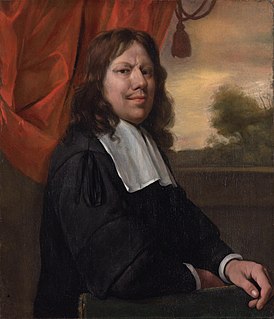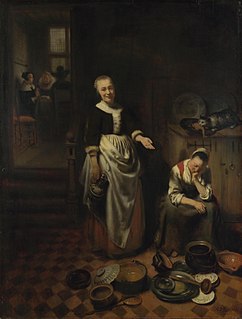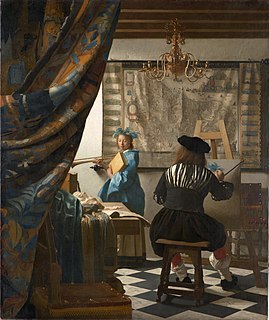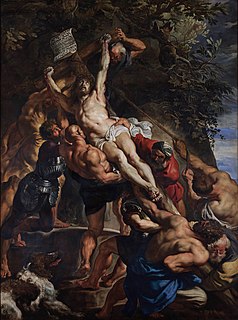
Jan Josephszoon van Goyen was a Dutch landscape painter. Van Goyen was an extremely prolific artist; approximately twelve hundred paintings and more than one thousand drawings by him are known.

The Rijksmuseum is a Dutch national museum dedicated to arts and history in Amsterdam. The museum is located at the Museum Square in the borough Amsterdam South, close to the Van Gogh Museum, the Stedelijk Museum Amsterdam, and the Concertgebouw.

The Mauritshuis is an art museum in The Hague, Netherlands. The museum houses the Royal Cabinet of Paintings which consists of 854 objects, mostly Dutch Golden Age paintings. The collections contains works by Johannes Vermeer, Rembrandt van Rijn, Jan Steen, Paulus Potter, Frans Hals, Jacob van Ruisdael, Hans Holbein the Younger, and others. Originally, the 17th century building was the residence of count John Maurice of Nassau. It is now the property of the government of the Netherlands and is listed in the top 100 Dutch heritage sites.

Jan Havickszoon Steen was a Dutch Golden Age painter, one of the leading genre painters of the 17th century. His works are known for their psychological insight, sense of humour and abundance of colour.

Genre art is the pictorial representation in any of various media of scenes or events from everyday life, such as markets, domestic settings, interiors, parties, inn scenes, and street scenes. Such representations may be realistic, imagined, or romanticized by the artist. Some variations of the term genre art specify the medium or type of visual work, as in genre painting, genre prints, genre photographs, and so on.

The Fitzwilliam Museum is the art and antiquities museum of the University of Cambridge. It is located on Trumpington Street opposite Fitzwilliam Street in central Cambridge. It was founded in 1816 under the will of Richard FitzWilliam, 7th Viscount FitzWilliam (1745-1816), and comprises one of the best collections of antiquities and modern art in western Europe. With over half a million objects and artworks in its collections, the displays in the Museum explore world history and art from antiquity to the present. The treasures of the museum include artworks by Monet, Picasso, Rubens, Vincent van Gogh, Rembrandt, Cézanne, Van Dyck, and Canaletto, as well as a winged bas-relief from Nimrud. Admission to the public is always free.

The Frans Hals Museum is a museum located in Haarlem, the Netherlands.

Teylers Museum is an art, natural history, and science museum in Haarlem, Netherlands. Established in 1778, Teylers Museum was founded as a centre for contemporary art and science. The historic centre of the museum is the neoclassical Oval Room (1784), which was built behind the house of Pieter Teyler van der Hulst (1702–1778), the so-called Fundatiehuis. Pieter Teyler was a wealthy cloth merchant and banker of Scottish descent, who bequeathed his fortune for the advancement of religion, art, and science. He was a Mennonite and follower of the Scottish Enlightenment.

Gabriël Metsu (1629–1667) was a Dutch painter of history paintings, still lifes, portraits, and genre works. He was "a highly eclectic artist, who did not adhere to a consistent style, technique, or one type of subject for long periods". Only 14 of his 133 works are dated.

Dutch Golden Age painting is the painting of the Dutch Golden Age, a period in Dutch history roughly spanning the 17th century, during and after the later part of the Eighty Years' War (1568–1648) for Dutch independence.

Genre painting, a form of genre art, depicts aspects of everyday life by portraying ordinary people engaged in common activities. One common definition of a genre scene is that it shows figures to whom no identity can be attached either individually or collectively—thus distinguishing petit genre from history paintings and portraits. A work would often be considered as a genre work even if it could be shown that the artist had used a known person—a member of his family, say—as a model. In this case it would depend on whether the work was likely to have been intended by the artist to be perceived as a portrait—sometimes a subjective question. The depictions can be realistic, imagined, or romanticized by the artist. Because of their familiar and frequently sentimental subject matter, genre paintings have often proven popular with the bourgeoisie, or middle class.

Jacques Goudstikker was a Jewish Dutch art dealer who fled the Netherlands when it was invaded by Nazi Germany during World War II, leaving an extensive and significant art collection including over 30 "Old Masters" which was looted by the Nazis. "Between the two World Wars, Jacques Goudstikker was probably the most important Dutch dealer of Old Master paintings", according to Peter C. Sutton, executive director and CEO of the Bruce Museum of Arts and Science. The Dutch government restored the paintings to the Goudstikker family in 2006, and they were sold at auction in 2007 for almost $10 million.

Flemish Baroque painting refers to the art produced in the Southern Netherlands during Spanish control in the 16th and 17th centuries. The period roughly begins when the Dutch Republic was split from the Habsburg Spain regions to the south with the Spanish recapturing of Antwerp in 1585 and goes until about 1700, when Spanish Habsburg authority ended with the death of King Charles II. Antwerp, home to the prominent artists Peter Paul Rubens, Anthony van Dyck, and Jacob Jordaens, was the artistic nexus, while other notable cities include Brussels and Ghent.

Museum Bredius is a museum named after Abraham Bredius on the Lange Vijverberg in The Hague. It is remarkable for its collection of etchings and paintings, but is most attractive to visitors for its accurate restoration of the 18th-century Herenhuis interior with period furnishings.

August Allebé (1838–1927) was a 19th-century artist and teacher from the Northern Netherlands. His early paintings were in a romantic style, but in his later work he was an exponent of realism and impressionism. He was a major initiator and promoter of Amsterdam Impressionism, the artist's association St. Lucas, and the movement of the Amsterdamse Joffers. Amsterdam Impressionism – sometimes referred to by art historians as the School of Allebé – was the counterflow to the very strong Hague School in the movement of Dutch Impressionism. As a professor at the Royal Academy of Amsterdam he fostered a cosmopolitan attitude toward art and the promotion and motivation of his students, and provided a significant stimulus to developments in modern art.
Daniël (Daan) van Golden was a Dutch artist, who has been active as painter, photographer, collagist, installation artist, wall painter and graphic artist. He is known for his meticulous paintings of motives and details of everyday life and every day images.

A Mayor of Delft and his Daughter (1655) is the common name of an oil on canvas painting by the Dutch painter Jan Steen. It is an example of Dutch Golden Age painting and is part of the collection of the Rijksmuseum. Since 2006 it has been determined that a more historically correct title is Double portrait of Adolf Croeser (1612-1668) and his daughter Catharina Croeser (1642-....).

Hendrik Frans Schaefels or Henri François Schaefels, also known as Rik Schaefels and Henri François Schaefels was a Belgian Romantic painter, draughtsman and engraver known for his seascapes, cityscapes, genre paintings, landscapes with figures and history paintings. He worked in the Romantic style popular in Belgium in the mid nineteenth century and was highly esteemed in Europe for his representations of historic naval battles.

Grada Hermina Marius or G.H. Marius was a Dutch writer and painter.

A Vase of Flowers is a 1716 floral painting by the Dutch painter Margaretha Haverman. It is in the collection of the Metropolitan Museum of Art.




















